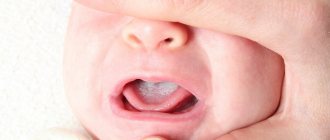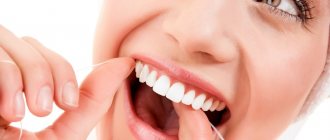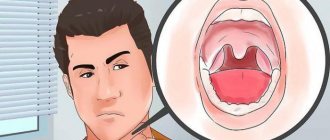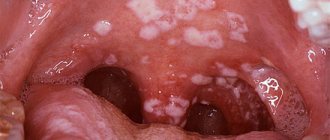Bad breath is a common problem that affects approximately one in three people. There is a medical term for bad breath - halitosis.
The appearance of an unpleasant odor may be a signal of health problems. In 90% of cases, halitosis is a consequence of poor hygiene or oral infections. Bad breath causes anxiety and embarrassment and makes it difficult to communicate with others, but it can be eliminated if the cause of its occurrence is identified and eliminated.
Causes of bad breath
The main cause of bad breath is the excessive proliferation of pathogenic bacteria in the oral cavity, which during their life processes release volatile gases with a characteristic unpleasant odor: hydrogen sulfide and methyl mercaptan. Plaque on the tongue, pieces of food stuck between teeth or in gum pockets are a consequence of poor hygiene and a breeding ground for microorganisms that spread a foul odor. In most cases, treatment by a dentist helps get rid of halitosis. Other causes of bad breath include:
- food with a persistent pungent odor (garlic, onions, some spices). During the digestion of garlic, volatile sulfur compounds are formed, which enter the blood and are carried throughout the body, ending up in the lungs, larynx and mouth. They become the cause of unpleasant “garlic breath”, which disappears completely only after 72 hours;
- smoking. Tobacco smoke itself has a persistent foul odor; in addition, it can provoke gum disease, which is a common cause of halitosis;
- dry mouth. Saliva is necessary for natural cleansing of the oral cavity. It washes away food particles, preventing them from rotting, and contains antimicrobial substances that inhibit the growth of pathogenic microflora. With xerostomia (a pathological condition characterized by decreased secretion or absence of saliva), the number of bacteria in the mouth increases significantly, which contributes to the development of caries and halitosis. Xerostomia can be caused by taking certain medications (hypotensives, chemotherapy, antiparkinsonian, etc.), as well as uncontrolled diabetes mellitus. Saliva production also naturally decreases during sleep. This leads to an increase in the number of bacteria in the mouth (mainly on the surface and back of the tongue) and the appearance of stale breath in the morning. Drinking alcoholic beverages, coffee and smoking are other causes of bad breath due to dry oral mucosa;
- diseases of the throat and nasopharynx. Bad breath can be caused by purulent plugs in the tonsils due to tonsillitis, bacterial or viral infections of the paranasal sinuses (sinusitis), chronic bronchitis and other diseases of the upper or lower respiratory system;
- diseases of the digestive system (gastritis, reflux), liver, kidneys, diabetes;
- fasting and low carbohydrate diets. They lead to the fact that the body, experiencing a lack of energy obtained from food, begins to burn accumulated fat reserves. When fats are broken down, ketone bodies are formed. These are by-products of fat metabolism, which are excreted from the body by the lungs and have an acetone odor.
What causes sour breath?
The most common cause of sour breath is acid reflux. This is a pathology of the gastrointestinal tract, accompanied by heartburn, pain in the lower abdomen, and less commonly, belching. Symptoms of acid reflux occurring more than twice a week are already characterized as gastroesophageal reflux disease (GERD) and must be treated. The main cause of reflux is a weakening of the lower esophageal sphincter, a valve-like muscle that forms a barrier between the esophagus and the stomach. Normally, the sphincter opens when swallowing food and then closes tightly. With reflux, it remains open, allowing gastric juice mixed with bile and pieces of undigested food to flow back into the esophagus. This causes heartburn, a bitter or sour taste in the mouth, and bad breath that gets worse with belching.
In some cases, a person with GERD may feel their own bad breath without even opening their mouth. The sharp sulfuric acid smell of bile from the esophagus can even be heard through the nose. Less commonly, sour breath can be a symptom of peptic ulcer of the stomach and duodenum, accompanied by increased acidity of gastric juice.
Bad breath due to gastrointestinal diseases
Bad breath in some cases can be a consequence of gastroenterological diseases. Most often, halitosis is provoked by gastroesophageal reflux (a pathological condition in which gastric contents enter the esophagus), as well as infection of the mucous membrane of the stomach and duodenum by the bacterium Helicobacter pylori. It can cause gastritis, ulcers and stomach cancer. In addition, the bacterium may also be present on the oral mucosa, which is also a cause of halitosis. There may not be any signs of gastrointestinal diseases.
The study, published in the journal Medical Principles and Practice, involved 18 patients with halitosis and confirmed H. pylori infection. 4–6 weeks after a course of antibacterial treatment, bad breath disappeared in 16 people. This study confirmed the relationship between Helicobacter pylori and halitosis.
Much less commonly, halitosis occurs due to intestinal obstruction. This is a health-threatening condition where food is unable to move through the digestive tract due to a blockage in the small or large intestine. Symptoms of the pathology: bloating, constipation, abdominal cramps, nausea, vomiting and fecal odor from the mouth. If you have these symptoms, you should immediately consult a doctor.
Why is the composition of the microflora disrupted? The causes of halitosis can be different:
- Poor oral hygiene: the child does not brush his teeth well, leaving behind plaque in which bacteria multiply.
- Numerous caries, gum inflammation. As a rule, persistent bad breath in a child is primarily caused by dental problems.
- Dry mouth. It is saliva that protects the oral cavity from bacteria and moisturizes the mucous membranes. There are many conditions that cause dry mouth, from not drinking enough or eating poorly to serious illnesses or taking certain medications.
- Diseases that cause a runny nose (allergic or viral). With nasal congestion, the child breathes through the mouth, which causes the growth of bacteria in the oral cavity and leads to additional inflammation of the tonsils. This leads to a disease such as chronic tonsillitis. When the surfaces of the pharyngeal tonsils become loose, food gets stuck in them and plugs form, the presence of which can cause bad breath in a child.
- Increased acidity, gastritis. This is a common cause of bad breath in teenagers. Usually the bad smell appears some time after eating. Also, with gastritis, reflux can occur - the backflow of stomach contents into the esophagus, which causes a sour smell from the mouth.
- Diabetes. The smell from the mouth in diabetes mellitus is specific - acetone (similar to the smell of rotten fruit). This smell can also appear with severe dehydration, if the baby has an intestinal infection with vomiting and diarrhea.
- Bad breath in infants is more common when bottle-fed. It may indicate insufficient fluid intake, thrush, or some other conditions.
Worms and other parasitic diseases are not the cause of halitosis.
How to remove bad breath from reflux?
Medication treatment, as well as making some changes to your usual lifestyle, can help prevent sour breath from developing with GERD. First of all, you need to stop smoking. Nicotine causes the sphincter muscles in the lower esophagus to weaken, which is the main cause of stomach acid refluxing into the esophagus. In addition, smoking itself causes bad breath and increases the risk of developing cancers of the throat, esophagus, stomach, pancreas, liver and colon. How to prevent bad breath from reflux:
- do not lie down immediately after eating - in a horizontal position, gastric juice flows into the esophagus, and the longer it stays there, the more irritated its mucous membrane is. You must wait at least 2–3 hours;
- Place a wedge-shaped pillow under your head to elevate your upper body while you sleep. This way the esophagus will be located above the stomach and gastric juice will not flow back and irritate its walls;
- eat small meals throughout the day;
- Maintain a normal weight to avoid pressure on the stomach. Obesity increases the risk of hiatal hernia, which can worsen GERD symptoms;
- Chew gum to freshen your breath and reduce the risk of heartburn.
Changing your diet can also relieve symptoms of GERD and prevent bad breath. Many foods can reduce the tone of the sphincter muscles of the lower esophagus and increase the acidity of gastric juice, thereby exacerbating the problem. Foods and drinks to avoid if you have GERD:
- alcohol;
- coffee and tea containing caffeine;
- onion and garlic;
- citrus fruits and juices from them;
- carbonated drinks;
- tomato juice;
- mint;
- spicy food;
- chocolate;
- fatty and fried foods.
Include more fiber-rich foods in your diet. These are pears, apples, avocados, artichokes, lentils, beans, broccoli, bananas, carrots and beets. They help improve digestion and avoid halitosis. Consume natural sourdough yogurt without fillers and milk, and drink enough water. Drug therapy for GERD involves the use of several types of drugs that reduce the production of hydrochloric acid or neutralize it:
- histamine blockers;
- proton pump inhibitors;
- calcium carbonate, aluminum or magnesium hydroxide.
Only a doctor can prescribe medications. Self-medication can be harmful to health.
What should you pay attention to first?
How can you determine that a teenager has already started using drugs? The use of illegal drugs is difficult to detect at the initial stage. But parents should still be wary if their children often have inflamed red eyes, a strange expression in the eyes, altered pupils, or redness of the skin. Suspicion should be aroused by the teenager’s unusual behavior, changes in appetite, and sudden changes in mood. You should pay attention to whether such changes are cyclical. If these signs are repeated too often, then you should have a serious conversation with your children.
Frequent chills, painful sensations in the limbs, dry skin or excessive sweating should also be on your guard. If a teenager often uses cannabis preparations, then a characteristic sweetish odor emanates from it.
Different groups of drugs manifest themselves differently. So, when taking opiate drugs, the pupils narrow, and when using cocaine, on the contrary, they dilate.
Teenagers' behavior is changing. They often begin to disappear from home, are not interested in family problems, lie a lot, they make new dubious friends, their school performance decreases, and their previous sleep and wakefulness patterns are disrupted. Parents should also be alerted to the loss of things from the house, the strange state of a teenager, similar to alcohol intoxication, but without the smell of alcohol.
How to eliminate unpleasant odor from the stomach?
The first step in dealing with bad odor caused by stomach problems should be to determine its true cause. To do this, you need to make an appointment with a gastroenterologist, since attempts at self-medication can harm your health. After examining the gastrointestinal tract, the doctor will prescribe a treatment regimen that will help solve the problem of bad breath. Taking probiotics (beneficial microbial cultures that improve the functioning of the digestive system) also helps normalize the acid balance of the stomach and reduce the number of pathogenic bacteria.
To prevent halitosis you can:
- Give your child enough fluids to drink;
- Limit the consumption of sweets, flour and confectionery products, this will reduce the activity of the formation of soft and sticky plaque;
- Brush your teeth thoroughly (remember that until the age of 8-9 years, a child cannot yet properly brush his teeth on his own, and he needs help);
- Teach your teenager to use dental floss, mouthwash, and if he has braces, then an irrigator.
make an appointment with a pediatric dentist online or by phone: +7
How to remove the smell of acetone from your mouth?
The smell of acetone on the breath usually appears when the body switches to the mode of burning accumulated fat due to the lack of carbohydrates from food to support all vital processes. This is a common side effect of low-carb or keto diets, but it is not harmful to your health. Breath with the smell of acetone or rotten apples disappears on its own a couple of weeks or a month after starting the diet, when the body fully adapts to the transition to a new source of energy.
In other cases, a sweetish fruity odor from the mouth may be a sign of an acute complication of type 1 diabetes - ketoacidosis. This dangerous health condition is caused by high levels of ketone bodies in the blood due to a lack of insulin. Symptoms of ketoacidosis:
- strong thirst;
- frequent urination;
- labored breathing;
- stomach ache;
- nausea, vomiting;
- confusion.
If these signs are present, you should urgently call an ambulance, since without timely treatment the patient may fall into a diabetic coma and die. Regular monitoring of blood sugar levels will help prevent the development of ketoacidosis in the future.
The following tips will help minimize keto breath while dieting:
- increase your water consumption. Ketones are excreted not only by the lungs, but also in the urine. Dehydration increases their concentration in the body and increases the unpleasant odor;
- eat less protein. When it breaks down, ammonia compounds are formed - another metabolic byproduct with a strong, unpleasant odor, which is excreted through the lungs and urine;
- Maintain oral hygiene: brush your teeth twice a day, use dental floss and mouthwash;
- Sugar-free mints or chewing gum will help freshen breath and increase the production of saliva, which has an antimicrobial effect and neutralizes bad odors;
- increase your daily carbohydrate intake.
Substance abuse among teenagers is a dangerous way to join the crowd
Substance abuse is a serious disease that is the first step to drug addiction. It poses a particular danger because it lures very young youth into its addiction. If previously these were various solvents and other household chemicals, now gas addiction is increasingly becoming the reason for adolescents being admitted to the hospital. How can parents recognize this serious addiction?
Teenagers very often resort to inhaling gases from lighters and cylinders. They consider this activity to be innocent fun that makes them feel like adults. Gathering in large groups, they engage in this dangerous activity. Young people have no idea what harm volatile toxins have on the body.
And if earlier this was considered entertainment for children from disadvantaged families, now even wealthy parents suffer from the addiction of their beloved children. An innocent hobby quickly develops into a serious illness, and stopping becomes increasingly difficult.
In case of severe poisoning, oneiric stupor may be followed by stupor and then coma. The strong smell of acetone from the mouth makes it possible to recognize the nature of these unconscious states. Sometimes stupor and coma are preceded by a sudden change from euphoria to an affect of fear (“fear of death”). When inhaling household gas containing propane-butane, toluene, in addition to euphoria, severe vegetative symptoms may be present - sudden fountain-like vomiting, severe dizziness, a feeling of lightheadedness, tachycardia, abnormal heart rhythm (arrhythmia), cardiac arrest, facial hyperemia, followed by severe pallor, spasm of bronchioles (inability to inhale air further death from suffocation).
During intoxication (stupefying), teenagers give the impression of being stunned; they seem to be disconnected from their surroundings. As if numb, they sit with their heads bowed. Their eyes are half-closed, there is a frozen smile on their face, they almost don’t react to the address, they wave it off, mutter something inaudibly. Some people experience psychomotor agitation (motor activity, senseless and erratic actions)
“Visions” are usually followed by asthenia, lethargy, apathy, depression with elements of malice. To avoid these consequences, the teenager “gets a hangover”, i.e. begins to inhale the toxic substance again after a certain time.
Most often, inhalant abuse occurs in groups. Group sizes vary - from 2-3 teenagers to almost the entire school class or almost all peers in one house. The group is formed at the place of residence (for example, an apartment building, a microdistrict in the city) or at the place of study. It was in companies that abuse inhalants that the phenomenon of group mental dependence was described.
There are also age and gender characteristics of inhalant abuse. Most begin to abuse in early or middle adolescence (12-14 years old), sometimes even as early as 9-11 years old. Subsequently, most stop inhalation. Some of them go on to abuse alcohol or other toxic substances.
Features of use.
Boys are more likely to abuse inhalants. Girls join groups of boys or inhale inhalants in their same-sex groups.
Another feature of inhalant abuse is its regional and time-limited distribution. Some substances are becoming “fashionable” among teenagers in some cities and localities and are not in others where other substances may be used. Over the years, some inhalants are replaced by others in the same area.
The motivation for abuse is most often curiosity, the desire to experience unknown experiences and sensations, as well as comfort with “one’s” peer group. An abundance of free time, the inability to occupy oneself with anything, and boredom are predisposing factors. These can also include failure to study and associated absenteeism due to reluctance to study and to be a laughing stock in the class. Trouble in the family.
Diagnostic signs of established substance abuse due to inhalant abuse are:
- transition from inhalations started in the company to inhalation of toxic vapors alone. This symptom is the most striking manifestation of individual mental dependence. But in rare cases, inhalants may be used privately from the very beginning, for example, for the purpose of “experimenting on oneself,” trying to break depression, etc.;
- an increase in the dose of a consumed toxic substance (“previously half a tube of glue was enough, now you need a whole one”) clearly indicates an increase in tolerance;
- daily long-term inhalations, sometimes for many hours in a row, during which the teenager either inhales vapors of toxic substances, then interrupts the inhalation, being half-conscious, and when waking up resumes it again. This symptom can also be considered as a manifestation of increased tolerance to a toxic substance;
- repeated inhalations within one day, day after day;
- malicious aggression (instead of embarrassment, attempts to escape, etc.) towards those who are caught inhaling and are trying to interrupt it, distract from worries, “break the high”;
- stopping attempts to hide inhalations from parents, educators, and strangers. In this case, the teenager appears in front of adults intoxicated (half-conscious), when he still smells strongly of the inhalant, there are stains of the inhaled substance on his clothes, an unkempt appearance, in his pockets there may be a bottle of inhalant (cellophane bags, vials of liquid, a tube of glue, lighters, a can of household gas) and sometimes even starts inhaling at home in front of his parents.
The long-term consequences of substance abuse are, first of all, dementia caused by the toxic effect of the substance on the brain.
A psychological examination reveals low intelligence. Attention disturbances are pronounced - difficulty concentrating, easy distractibility, inability to maintain attention on one thing for a long time. Short-term memory, both mechanical and operational, is also impaired.
Teenagers become less intelligent, slower and less oriented in their surroundings, especially in cases where quick reactions are required. Their peers pay attention to this (in teenage slang they are said to be “not whipping”, “not catching up”, and other expressions, i.e., they are unable to quickly take into account the conditions of a rapidly changing situation). The ability to assimilate new educational material drops sharply—this is often the reason why teenagers drop out of school, categorically refuse classes, and even run away from home and boarding schools. For some, increasing passivity, lethargy, slowness, and a tendency to stay away from peers and seek solitude, spending time in idleness, predominate. Others have a tendency to affective reactions, anger, pugnacity, and aggression at the slightest provocation. Strong exposure to butane and propane can cause atrial fibrillation, which can lead to death. The resulting poisons have a detrimental effect on all organs. This means that after two years of substance abuse, the patient can turn into a weak-minded disabled person. This happens due to developmental delays; the teenager’s intelligence decreases, he stops thinking and developing. Inhalation of gases (vapors from household chemicals) can also result in other complications:
- lung diseases;
- weakening of the immune system;
- bone marrow damage;
- respiratory arrest;
- cirrhosis of the liver;
- cardiopalmus;
- death due to suffocation or mechanical damage.
Substance abusers often become victims of accidents at home, on the roadway. It is not uncommon among them to die from suffocation due to blockage of the respiratory tract with vomit, pulmonary edema in response to the penetration of vapors (gases) into the bronchi and alveoli. Poisons (inhaled toxicants) act on the control centers of the vital reflexes breathing and heartbeat. At any moment, volatile poisons can turn off the respiratory reflex and stop breathing.
Stopping breathing can occur right on inhalation - so quickly do the toxin vapors reach the brain. The release of stress hormones into the blood causes rapid heartbeat, disruption of nerve impulses that control the functioning of the heart,
Signs parents should watch out for:
- the presence of a strong odor (solvents, glue, gasoline, any household chemicals) from the child’s clothes;
- redness of the eyes;
- tearfulness;
- the appearance of ulcerations in the oral cavity;
- numerous scratches on the child’s face and body after ordinary walks, dirty and scuffed clothes;
- a change in the child’s mental state, the desire to study disappears, frequent absences from classes, grades deteriorate, interest in his hobby disappears, his social circle changes;
- a teenager (child) becomes absent-minded and forgetful;
- new “shady” friends appear, most often of a criminal nature, or the group with which the teenager previously communicated began to behave somehow strangely (spends time aimlessly in the courtyards, does not participate in school events, the social life of the school, keeps to himself, periodically group members are in the field from the perspective of the juvenile department of the police).
Dear residents of the city, do not be indifferent to the manifestations of substance abuse in teenagers!
If in your entrance, open attics, basements, outskirts of the city, near garages, in summer cottages (especially abandoned ones), on construction sites, in the territory of unguarded enterprises, teenagers who behave inappropriately gather, after their stay empty lighters and cans of household chemicals, bags with traces of any substance, report to the police. Do not arrange “showdowns” with teenagers on your own. If you see a teenager in a helpless state, unable to move or with signs of intoxication (stupefaction), call an ambulance.
Narcologist “Helpline” - 8 (34670) 2-08-52
Psychiatrist-narcologist Zaika V.V.
What to do if your breath stinks?
The fight against bad breath should begin with a visit to the dentist, since most often halitosis is a consequence of poor oral hygiene and the resulting diseases of the gums and teeth. If the doctor does not find any problems, then the cause probably lies in gastrointestinal diseases, and you need to visit a gastroenterologist. Following these recommendations will help get rid of halitosis:
- Brush your teeth thoroughly at least twice a day (especially after meals), using a toothpaste containing fluoride, as it helps strengthen the enamel. Using a toothpaste or mouthwash with antibacterial ingredients kills bacteria in the mouth that causes bad odor;
- floss at least once a day to remove food particles stuck between your teeth;
- clean the surface of your tongue daily with a special scraper or toothbrush to remove plaque, which is a breeding ground for pathogenic bacteria;
- Clean your removable dentures regularly (at least once a day or as directed by your dentist);
- avoid dry mouth - drink more clean water, chew sugar-free gum to stimulate saliva production;
- Avoid consuming garlic, onions, hot spices, alcohol and coffee. Limit your sugar intake - it promotes the growth of microbes, which turn it into acid, which destroys tooth enamel;
- change your toothbrush every three months;
- Get a routine check-up with your dentist every six months.
Halitosis in children: symptoms and treatment
To know exactly how to treat halitosis in a child, you need to find out its causes. The first doctor you should contact in this case is a dentist. Dental causes of halitosis are the most common. During the examination, the dentist will check the condition of the teeth and gums, check how much plaque is in the mouth and on the teeth, and especially on the tongue, and what color it is. Based on the results of the examination, the dentist can draw conclusions about whether halitosis is a phenomenon of dental origin, or whether the cause should be sought from other specialists - an otolaryngologist or gastroenterologist. If the problem is truly in the mouth, dental treatment will help your child get rid of halitosis, and good oral hygiene will help maintain fresh breath in the future.
Meet our tooth fairies and check prices.










